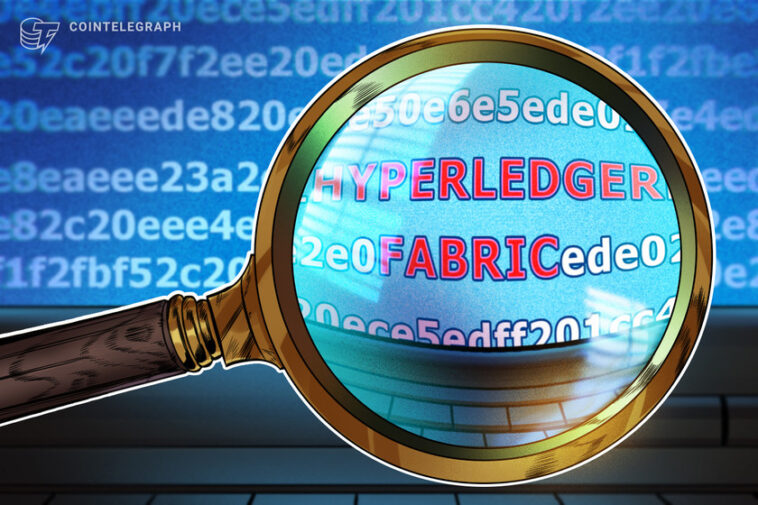IBM shows its commitment to Hyperledger and enterprise blockchain development with its largest-ever contribution of open-source code.
The global blockchain technology market size is projected to reach $72 billion in the next five years. In order to ensure this growth, however, blockchain solution providers must continue to advance and innovate.
For example, public enterprise blockchain use has become an ongoing trend this year as companies like ConsenSys aim to drive adoption for open, permissionless networks. On the flip side, it’s important to point out that private blockchains are still being leveraged by enterprises and will continue to be utilized as innovation continues.
Advancing open, permissioned blockchain networks
Most recently, computing giant IBM announced that it has open-sourced a large portion of its Hyperledger Fabric code to help drive up adoption rates for enterprise blockchain use cases.
Kareem Yusuf, general manager of AI and blockchain applications at IBM, told Cointelegraph that this is one of IBM’s largest contributions to open-source code. He further noted that the company is unveiling a new Hyperledger Fabric support offering, along with donating the code that supports token exchanges on Hyperledger Fabric, known as Fabric Token SDK. Yusuf said:
“Our intent is to make sure we have a vibrant and active Hyperledger community. To support this, we have announced two key moves. One is the donation of our management console code capabilities, which was in our IBM Blockchain Platform, into the Hyperledger Labs world. Another is making available a support offering for those wishing to use Hyperledger Fabric with full-product support from IBM.”
According to Yusuf, IBM’s significant code contribution will make it easier for Hyperledger users to utilize Fabric, which is an enterprise-grade distributed ledger platform that caters to a variety of enterprise use cases. IBM’s blockchain platform is powered by Hyperledger Fabric.
It’s also worth mentioning that Hyperledger was launched in 2015 by the Linux Foundation as an open-source collaborative effort to advance cross-industry blockchain technologies. Hyperledger hosts a number of enterprise blockchain projects such as Fabric.
Brian Behlendorf, executive director of Hyperledger, told Cointelegraph that IBM’s new contributions will specifically make it easier for every developer to build on top of and manage a Fabric blockchain network. He further noted that these new efforts are organized as “Labs,” which are separate projects from Fabric but are used to build upon the Fabric framework.
For example, Behlendorf pointed out that Fabric’s “Token SDK” will help formalize the approach for managing tokens on top of Fabric. Building tokens on top of Hyperledger has always been possible, as Metacoin (MTC) was the first cryptocurrency built on Hyperledger to achieve mainnet status in 2018. Although this is a feature offered to developers, Behlendorf noted that it had previously required a lot of “do-it-yourself” effort. “Now that gets a better-supported approach,” he remarked.
Behlendorf added that another Lab, the “Fabric Smart Console,” makes managing a cluster of Fabric nodes across a network even easier to monitor and manage. Both of these Labs should become more accessible for developers to leverage once IBM’s full-support offering is available in the Red Hat Marketplace sometime this fall. The offering will include access to IBM-certified images, code security scans and around-the-clock customer support. Yusuf added:
“Being able to manage Hyperledger Fabric has been challenging. A major thing to consider here is support. If all costs of support are embedded in a single project, this can’t be monetized across other projects, and it becomes more expensive. A standardized support offering, however, can be very well structured to fit across multiple use cases.”
Specifically speaking, Arun S.M. — Hyperledger contributor, leader in the Hyperledger India chapter and member of the Hyperledger Technical Steering Committee — told Cointelegraph that the announcement of Fabric Smart Console, the crux of operations part of IBM Blockchain Platform, came as a surprise, noting that the secret sauce has now been revealed:
“There are projects within Hyperledger (including Labs) that can deploy a network, help to visualize and monitor deployed networks, including performing operations to varying degrees. What brings in excitement around the latest announcement is that IBM Blockchain Platform is used in many production applications. It is mature and seasoned. Having a self-hosted management portal with an intuitive UI that can hide complexities and reduce the network administration is a blessing in disguise for many.”
Ultimately, Yusuf explained that these new offerings will help increase adoption for enterprise blockchain use cases looking to leverage permissioned networks. Moreover, Yusuf noted that open-sourcing the Fabric code will help bring down costs, which has been a primary challenge for small-to-medium-sized companies looking to use permissioned networks.
This is important for a number of reasons. For instance, even though one industry report shows that public blockchain adoption has emerged as the leading market segment, Yusuf mentioned that enterprise use cases that leverage a shared, permissioned blockchain are still critical — especially for use cases like supply chain management:
“By definition, a supply chain is a network that involves sharing information between suppliers and different parties, so you need a blockchain infrastructure to tackle inventory visibility, provenance, responsible sourcing and more.”
By allowing Hyperledger Fabric’s base foundation to be open, Yusuf believes this will encourage more people to engage and collaborate using permissioned networks.
Hyperledger community is expected to grow
In addition to advancing enterprise blockchain adoption using open, permissioned networks, IBM’s contributions may draw more developers to the Hyperledger community.
According to Behlendorf, the impact of IBM’s open-source offerings will bring more developers to Hyperledger Fabric and the community as a whole. “This will hopefully inspire more to cross over into becoming contributors and core maintainers as well,” he remarked.
Related: As Microsoft Azure closes shop, ConsenSys Quorum opens up to new users
As such, enterprises leveraging Hyperledger Fabric are likely to grow. For example, the Filecoin Foundation recently announced that it has become a member of the Hyperledger community. Marta Belcher, board chair of the Filecoin Foundation, commented that Filecoin’s (FIL) decentralized storage capabilities have tremendous potential in the enterprise space. “We’re thrilled to join Hyperledger, a leader in enterprise blockchain technology, to explore these possibilities,” she said.
It’s also noteworthy that IBM’s contributions to Hyperledger Fabric demonstrate the company’s commitment to advancing enterprise blockchain. This is key to recognize, as it was previously rumored that IBM Blockchain’s team was “dissolving.”
Yusuf remarked that he’s particularly focused on scale and adoption moving forward. “From IBM’s perspective, you can expect to see use cases that leverage blockchain to bring actual end value to our customers.”





 BTC-USD
BTC-USD  ETH-USD
ETH-USD  LTC-USD
LTC-USD  XRP-USD
XRP-USD